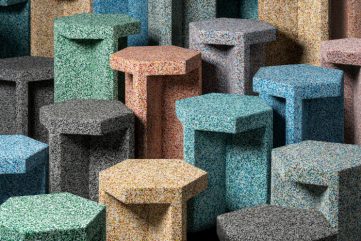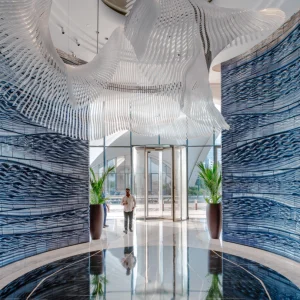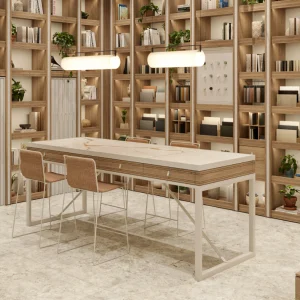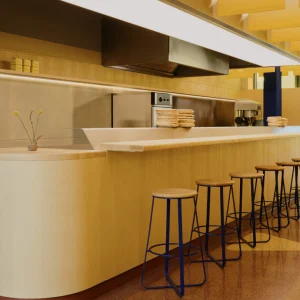
Edited By Kay Hill
Out of a shell

DINORAH MARTÍNEZ SCHULTE, founder of Mexico-based design studio Manufactura, joined forces with Nancy Diniz and Frank Melendez of bioMatters to find a new use for a problematic waste product. The Maine lobster fishery is one of the US’s oldest industries, catching around 45,350t of lobsters a year, but their shells are generally dumped in the sea or in landfill. During a residency at the Haystack Mountain School of Crafts in Maine, the team worked out a way of grinding the shells and mixing them with organic binders and local clay to create a novel material that could be 3D printed. First shown in the UK at DesignMatters, it has been named ChitinCrete, as the lobster’s exoskeleton is made of chitin.
Civilised veneer

BELGIAN WALLCOVERING specialist Omexco has captured the ancient art of marquetry and combined it with the simplicity of a wallpaper. The company’s new Imperialis range features delicate slivers of natural wood veneer from the Japanese paulownia tree, placed by hand on a gilded backdrop. The handmade wallpaper is sold by the metre, with a 91cm width, in a wide range of geometric patterns that have a luxurious retro feel. The wallcovering is rated as eco-friendly, with good resistance to fading.
Good hair day
DUTCH DESIGNER Sanne Visser has been working on exploiting the design potential of human hair for nearly a decade – the UK alone sends around 6.5 million kilogrammes of human hair waste to landfill each year, yet as a material it is flexible, has a high tensile strength and is lightweight yet insulating. Her research includes textiles and ropes made from human hair, for both interiors and commercial uses, including the possibility of using hair as a natural and sustainable alternative to polluting nylon fishing nets.
Stools with soul

EACH YEAR, approximately 20 billion pairs of shoes are produced globally, with 95% eventually ending up in landfill. One of the largest components of shoe waste is rubber, which decomposes extremely slowly and produces toxic gases if incinerated. The design team at Guangzhou-based Bentu has been looking at ways to reuse this rubber, and has created a range of weatherproof, indoor/outdoor stools, each made with 90% recycled rubber from around 60 shoes. The colourful, hexagonal WU stools are the company’s second foray into recycled rubber, following an earlier swivel-stool design, XUAN, while “#” is a dual-purpose stool/side table made from recycled plastic waste.
Grass is greener

SABAI GRASS IS a lush plant that grows wild in the eastern and northern parts of India. Traditionally used in ropemaking, it can also be woven to create beautiful basketware. Now, Brazilian designer Humberto Campana has gone a step further by showing how the fibres can be used to create furniture, with his one-off design for the Atuxuá cabinet, created by sewing each blade of grass on to a bamboo lattice to recreate the impressive mass that Sabai grass represents during its harvest. Merging Estúdio Campana’s contemporary Brazilian design with traditional Indian materials and craft skills, Atuxuá was created for the Æquõ gallery in Mumbai, India’s first collectible design gallery.
Clearly better

THE GOOD PLASTIC Company has introduced a versatile new range to its Polygood brand: the Translucent Collection. Made from 100% recycled plastic, mainly from old sheer CD cases, the material is almost transparent, with natural pigments or other recycled plastic items used to create a variety of colours and finishes, with a matt or glossy surface. Available in 12mm or 19mm thicknesses, the 2,800 x 1,400mm panels are waterproof and fireresistant and can be backlit to create bold reception desks, wall accents or even furniture.
Lavender’s green

ORGANOID NATURAL SURFACES, based in the Tyrolean Alps, has launched wallcoverings that bring the sight and scents of the natural world indoors. Available as wallpapers on a linen or FSC-certified paper backing, and as a self-adhesive PVC-free film, the company’s materials are minimally processed to retain their natural look. Its Almwiese design, for example, is made from local, handcut Alpine hay and flower petals, while Bergwiese also includes the definitively Alpine flower, Edelweiss. Hypoallergenic, yet infusing the room with the smell of a newly mown meadow, Almwiese is certified as carbonneutral and supports local farming. Other designs use waste materials including moss, pine shavings and peppermint from the food industry.
Eternal textile

VIVÈRDIE INDUSTRIES is a Dutch design company dedicated to sustainable textile development. Its first product in full production, launched at Material Matters, is Vifour, made from 95% natural and synthetic recycled fibres from textile waste, with a compostable binding material. The colour palette is directly derived from the original recycled source materials. The material is infinitely recyclable, and is available in five different thicknesses, suitable for everything from upholstery to rugs, as well as in pre-fabricated acoustic panels combining Vifour with reclaimed wood and natural wool.
Clear as rock

WHILE ALABASTER has been mined in Tuscany for around 3,000 years, lighting company Alabastro Italiano has come up with a new way to use this elegant stone, making the most of its natural translucence to create a striking range of contemporary light fittings, including the Futatsu pendant light, shown. Crafted in Italy, the range of wall, ceiling and table lights creates an elegant new use for a traditional material, keeping local craft skills alive.





